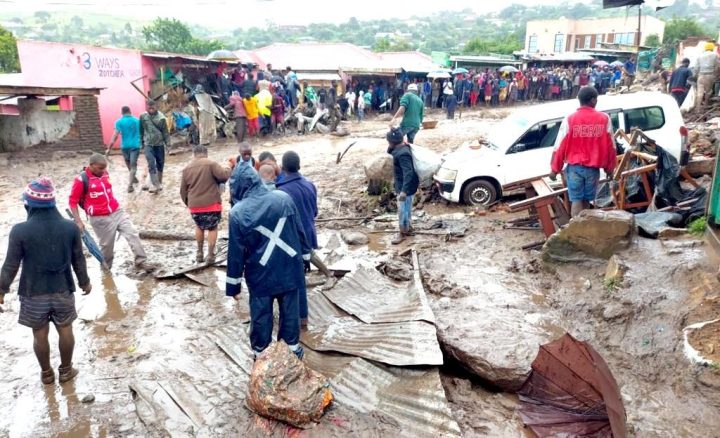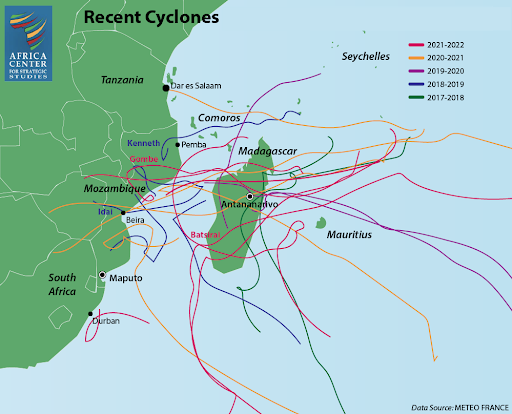ISS TODAY OP-ED
Fears persist that Cyclone Freddy’s record-breaking devastation is becoming the new normal

Thousands have been displaced by weather-related disasters in southern Africa, which are becoming more brutal and frequent.
Tropical Cyclone Freddy, which struck southern Africa between February and March, broke multiple records for both power and duration. Running for just over five weeks and increasing in intensity in its last week, it caused major destruction, displacement and death across Malawi, Mozambique, Madagascar, Zimbabwe and Mauritius.
Freddy developed near Australia on 4 February and travelled over 8,000 km across the southern Indian Ocean, where it struck Madagascar on 21 February and southern Mozambique three days later. After two weeks it looped back, landing in Mozambique and moving inland to Malawi.
Read more in Daily Maverick: Cyclone Freddy’s deadly trail of destruction a grim reminder of the need to prioritise climate adaptation
The cyclone broke or matched records for most accumulated cyclone energy, longest-lasting and most cycles of intensification. Only four storms have ever been known to cross the southern Indian Ocean from east to west. The most recent were Tropical Cyclones Leon-Eline and Hudah, both in 2000. Before Freddy, Eline was the longest-lived cyclone in the Indian Ocean and wreaked havoc in southern Africa.
These records are unlikely to hold for long. As climate change warms oceans, heat energy from the water’s surface fuels stronger and more frequent tropical storms that make landfall over more expansive territories. While such storms have long featured in the southern Indian Ocean, their intensity is rising, and southern Africa will be hardest hit.
The number of cyclones in Africa has doubled since the 1970s. Since 1994, there has been a progressive rise in high-category storms. An average of three cyclones now come off the Indian Ocean each season (November-April). In 2021-22, there were six.
Before 1980, southern hemisphere cyclones moved in regions between 5°and 20° south of the equator but now reach further southward. These included Issa in April 2022 — the deadliest to have struck South Africa. In 2019, Africa’s deadliest (Idai) and strongest (Kenneth) cyclones ever recorded hit in March and April.

Chart 1: Recent cyclones in the South-West Indian Ocean. (Source: Africa Center for Strategic Studies from Meteo France data)
Freddy has done its worst damage in southern Malawi. By 29 March, at least 707 people had died across southern Africa due to excessive flooding; 511 of those in Malawi alone. The country also reported over 1,300 people injured and 556 missing and unaccounted for. More than 508,000 people were displaced by the cyclone in over 530 sites, contributing to a dire humanitarian situation.
The floods have disrupted Malawi’s power supply countrywide, washed away infrastructure (including toilets), destroyed or contaminated community wells and damaged water supply networks. Access to clean water is now more limited than before, and Malawi was already battling its deadliest cholera outbreak before Freddy hit. Flood waters have exacerbated the situation in Malawi and Mozambique, and new cholera cases have been confirmed in multiple districts and in neighbouring countries.
Many health centres and marketplaces in Malawi remain inaccessible or have insufficient stock. Food prices have risen. In the Nsanje district, the cost of maize increased by 400% since last year. Schools were damaged and are being used as shelters for displaced people, and over 490,000 children have been unable to return to school.
Freddy affected another one million people in Mozambique, Madagascar, Zimbabwe, Mauritius, and Reunion, displacing at least 160,000 in these countries. Some were still affected by earlier disasters and now face secondary displacement. In Sub-Saharan Africa, 43% of displaced people are hosted in countries vulnerable to climate change.

Chart 2: Internal displacements, in millions, in Sub-Saharan Africa, 2012-2021. (Source: 2022 Global Report on Internal Displacement)
Globally, extreme weather events, including cyclones, floods and droughts, are now the leading reason for people fleeing their homes. Over the past decade, they have displaced an average of 21.6 million people annually, and this number will increase. In Sub-Saharan Africa, the Internal Displacement Monitoring Centre estimates that weather-linked disasters have displaced over two million every year since 2017.
It is becoming increasingly difficult to separate disasters from conflict or other causes of displacement as in most cases, multiple drivers are converging.
The Danish Refugee Council’s 2023 Global Displacement Forecast predicts that Sub-Saharan Africa will see the biggest increase in new displacements in the next two years. Most will happen in countries facing complex multi-crisis situations. Climate impacts — both sudden and slow-onset — compound violence, insecurity and weak governance. According to the Danish Refugee Council, over 100 million people in 26 countries in Sub-Saharan Africa will be displaced by 2024 — double the figure in 2015.
Mozambique is an example of a country experiencing multi-crisis situations. Since 2017, the Cabo Delgado insurgency has displaced one million, killed at least 4,600, gravely impacted livelihoods and contributed to food insecurity and malnutrition. In 2023, this violence could displace 200,000 more people, primarily families with children.
In 2019 when Cyclones Idai and Kenneth hit Southern Africa, Kenneth devastated Cabo Delgado — the epicentre of Mozambique’s insurgency. The province experienced the worst impact in Mozambique’s history. Extreme weather events can intensify conflicts as scarce resources in affected areas dwindle. Violent disputes over resources can erupt, as is happening in Cabo Delgado, where land for farming is highly contested.
While crises are growing in size and complexity, funding is shrinking. Both humanitarian aid and official development assistance fail to meet the rising requirements. The global humanitarian gap — the gap between needs and funding — reached a record $23-billion in 2022.
The prospects for southern Africa are dire as wealthier countries continue to fall short of their climate commitments. With the number of displaced due to climate impacts and violence increasing, so too do their humanitarian needs.
Tropical Cyclone Freddy’s trail of devastation is a stark reminder of the urgent need for climate-sensitive programming, mitigation and adaptation. People and communities require funding, technical support, technologies and early warning systems that allow better responses to these disasters. DM
Aimée-Noël Mbiyozo, Senior Migration Research Consultant, Institute for Security Studies (ISS) and Ottilia Anna Maunganidze, Head, Special Projects, ISS Pretoria.
Research for this article was funded by the Hanns Seidel Foundation
First published by ISS Today.



















Comments - Please login in order to comment.